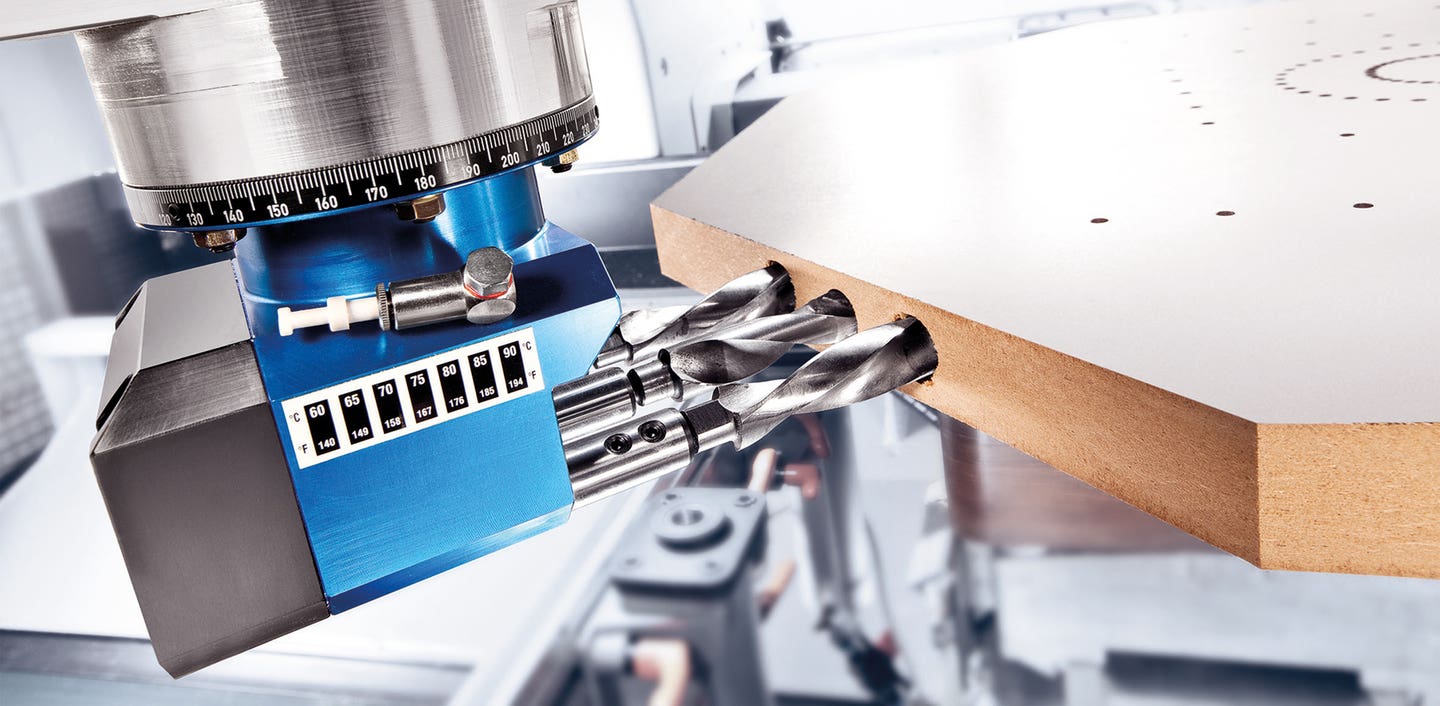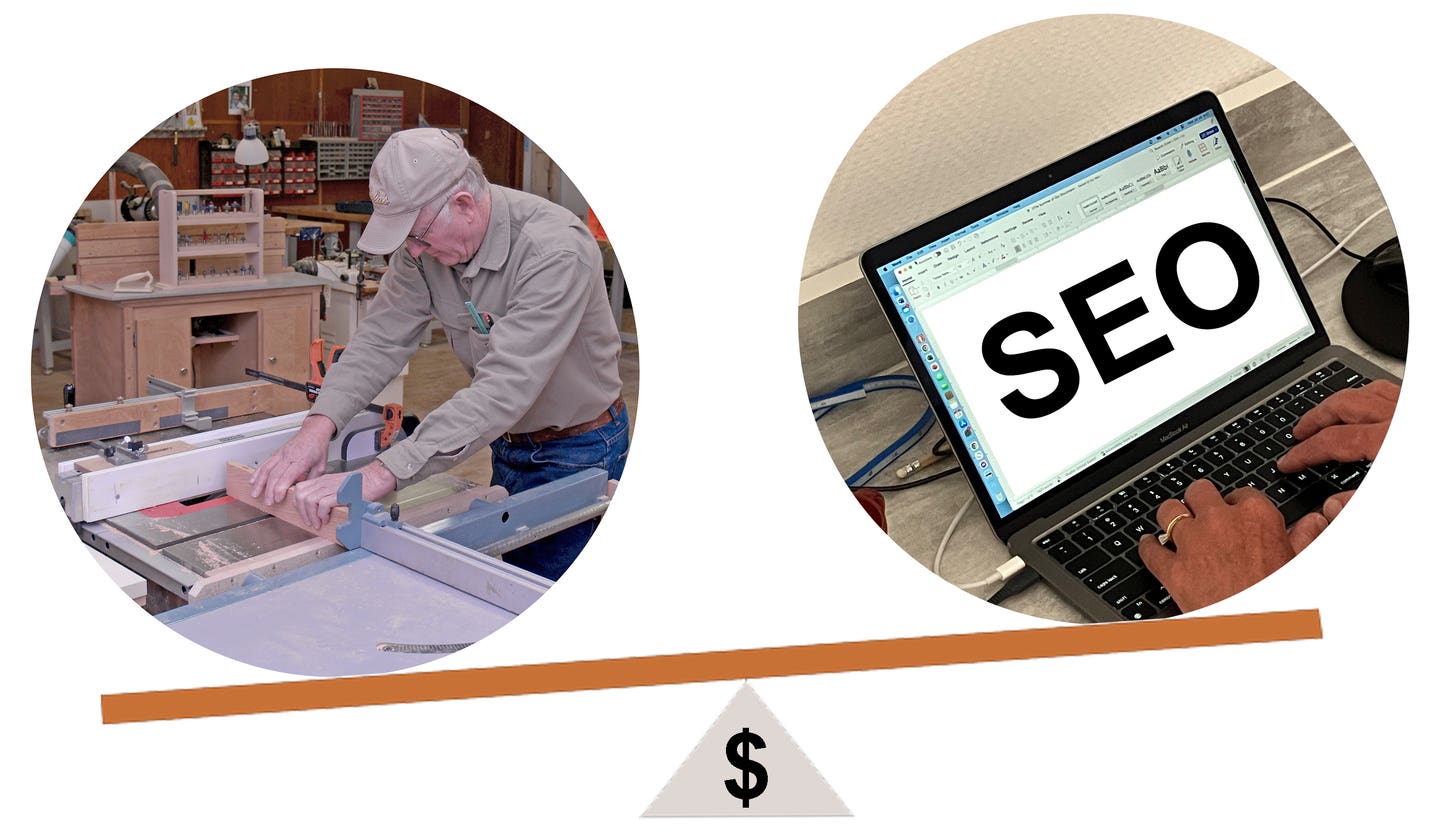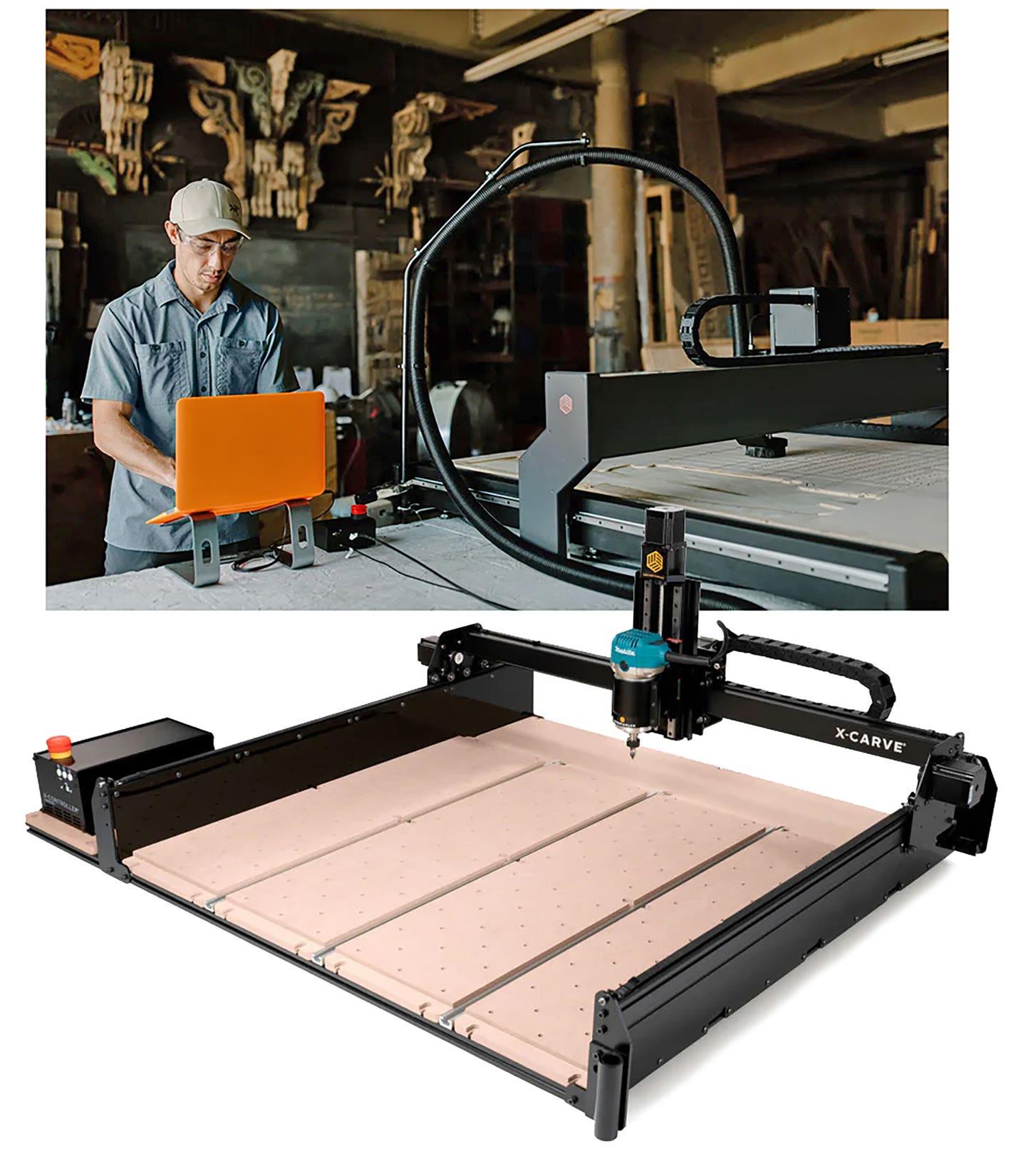A large part of the decision to purchase or upgrade a CNC revolves around the software. Woodworkers are comfortable running physical machines but telling them what to do on a screen can be a little intimidating. That’s especially true if the shop is moving up to CNC automation from traditional machines for the first time. There’s a pretty short learning curve to building basic boxes and, just as it is with any piece of equipment, the gray areas come into focus over time as projects are designed and built.
CNC software is so widespread now and so uniform that there’s a huge reserve of help available. That can come from online discussions and forums, in-house training, remote instruction from both the manufacturer and third parties via platforms such as Zoom, and often from an employee who just has the knack and will step right in.
Easing the learning curve
If the terminology below is unfamiliar or confusing, a good place to start might be an online class in CNC software (they’re easy to find), or else check with local colleges to see if there’s an introductory course that can be audited in person. Several manufacturers also offer guidance.
For example, Axiom Precision (axiomprecision.com) offers both online and in-house training in Vectric design software and basic CNC operation either before or after a woodshop has purchased a CNC. The classes explore 2D, 2.5D, and 3D aspects of design, and offer a step-by-step explanation of various features. And as with most reputable manufacturers, Axiom hosts a large online forum with thousands of posts that can address most of a new user’s questions about CNC software.
Vectric (vectric.com) is an employee-owned software developer specializing in applications that are designed to make cutting parts using CNC technology a highly productive and enjoyable experience. It’s a great program for small shops just getting started.
CNC router training is also available at individual woodshops or else at the San Diego office of CNC Parts Dept. (cncpd.com). The company’s three-day CNC router training course is California state certified and includes machine orientation, operation, maintenance, repair, a walk-through of the electrical system, and advanced options that are tailored to the trainee’s requirements. Both 3- and 5-axes training courses are available.
SCM Group (scmgroup.com) provides technical training courses and continuous qualifications for machine operators and maintenance technicians with the possibility of tailor-made courses for specific machines or processes.
Another state-of-the-art resource is the Stiles University (stilesmachinery.com) that lets a woodshop choose from more than 20 regularly scheduled courses, including introductory classes on machine operation, as well as advanced CNC programming, effective troubleshooting and maintenance. Some of the more popular courses are now available online as easy-to-consume videos and knowledge checks, and many are machine or brand specific. Stiles will train a shop’s personnel on a specific machine or process at one of the company’s training centers, online, or at the woodshop. Topics include areas such as nested-based CNC operation, working with vacuum pods, and through-feed CNC fundamentals.
Most machine manufacturers and software publishers offer some degree of training but be aware that many trainers report their students come into the class thinking they know a lot less, or more, than they actually do. It’s important to plan for training, and to itemize exactly what the shop needs to get up and going, or to improve some aspect of production. There’s not much point in sending an employee to a seminar that he/she is already more than qualified to teach, or signing them up for a class that is either irrelevant or over their head. So before registering, it’s essential to take stock of the class, the employee’s skills, and the shop’s needs. And if possible, the training should be in the specific CNC software that will be used every day.
New and improved
The 2023 version of Router-CIM from Florida-based Cim-Tech (cim-tech.com) is a CNC programming package that combines computer-aided manufacturing (CAM) with the design and drawing potential of AutoCAD. The concept of CIM (computer-integrated manufacturing) was developed by this company to bridge the gap between computer-aided design (CAD) and CAM. CIM provides a common interface for design and manufacturing, and the new package includes features such as the ability to create single parts as well as nested-based programs, automated scrap management, labeling, production and yield reporting, and detailed toolpath and nesting simulation. It lets a woodworker draw in 2D and 3D and program from two to five axes, including complex aggregate machining. The shop can create macros, choose from a library of doors, and program drilling operations that minimize cycle times at the CNC machine. Router-CIM can import and export XLS and CSV files, support drag and drop windows, and reduce machine interference issues with its automatic G-code scanner.
The Biesse Group (biesse.com/na) has created a package of software solutions called the B-Suite that includes modules for solid wood, edge banding, nesting, windows, and doors. The woodworking program, B-Solid, is a CAD/CAM option that has 3D modules designed for job planning, machine operation simulations, and virtual prototyping among others. According to the literature, it allows “importing or drawing any type of project (2D and 3D), from the easiest to the most complex, thanks to a unique design system.” It will verify the accuracy of the toolpath, and offers the ability to create and modify cutters, blades and bits. It checks for potential collisions with the machine or fixturing hardware, and then figures out how long a process will take. The edge banding module, B-Edge, generates a sequence for that task and manages the tape and machines. And the nesting module, B-Nest, optimizes and then manages sheets, parts and labels.
Last October, North Carolina-based Eurosoft (eurosoftinc.com) released a major update to its BlueCell optimization and nesting software. Version 2.0 includes the addition of a comprehensive machining data display, as well as updates to the pattern and grain editing interfaces. Performance and technology were also a focus. The publisher offers several CNC software solutions including Framework, a program that combines a simple, non-CAD way to combine parametric part templates with machining to create flexible product libraries. Framework also provides the ability to export a cut list or send parts data to CNCs and panel saws.
Mozaik Software (mozaiksoftware.com) was acquired by Cyncly at the end of 2022. Mozaik provides software solutions tailored to custom woodshops that build cabinets, closets and casework. The product suite covers the entire process from design to manufacture and is CNC-machine ready. The core programs are Mozaik Manufacturing (for designing, generating cut lists, figuring material and hardware requirements, producing part labels, and more); Mozaik Manufacturing with Optimizer (adds the ability to optimize parts for table or panel saws); and the CNC Version that has nesting and machine-ready G-Code capabilities. The company also offers optional units for nesting, labeling and rendering, plus a family of three ‘paperless’ apps for cutting, labeling and assembling.
Easel Pro is designed to work with over 30 types of CNC routers, and the software package from Inventables (inventables.com) has now added 3D carving so it’s ideal for shops that are designing and milling three-dimensional reliefs.
Packaged solutions
The publishers of KCD Software (kcdsoftware.com) say it is “the easiest software to learn and use”, and its suite covers functions such as design, pricing and building. Its cloud-based sharing aspect allows for both designing on a desktop or at a client’s house with a tablet. Initial cabinetry layouts can be roughed in using preset cabinet units with hundreds of door styles. There are libraries for frame and frameless cabinets plus closets, as well as wood libraries. From there, a designer can change the door panel sizes, colors, textures, countertop edging, and much more. The software is parametric and cabinet-smart, so it will automatically change pricing, parts lists, door lists (more than 300 styles), Cabinotch orders, or CNC machining for accurate construction as each change is made. KCD Software can also streamline information and share data with popular optimization, cabinet shop management, or laser measurement software.
Hexagon’s familiar Cabinet Vision is CNC software for residential and commercial cabinet manufacturers and closet builders that includes CAD tools and push-button CNC code. It allows professionals to easily design, detail, sell, and produce jobs with industry-specific tools. Hexagon’s Casebuilder (alphacam.com) is a package that specifically supports the manufacturing of kitchen and commercial cabinet jobs. Casebuilder allows the shop to configure the quantity and positions of doors, drawers, shelves and rollouts, and automatically generate drawings. It was designed with the small- to mid-sized residential or commercial cabinet shop in mind. Included are features such as order entry, a custom cabinet catalog, and construction options such as face-frame, overlay, frameless and 32mm.
CabMaster (cabmastersoftware.com) has an international flavor with a head office in Australia and U.S. headquarters on the West Coast. The design package includes drag and drop tools for drawing plan and elevation views of cabinets, closets and entire kitchens, and it’s relatively simple to modify. The package also includes an extensive hardware library, plus the ability to create cut lists and photo-realistic rendered drawings. The program is very customizable and versatile, and there’s an option to add a Panel Estimator optimizing tool. The basic package starts at $75 a month. The next step up is the manufacturing package (starting at $249 a month) that includes the shop drawings, rendering and other tools such as labeling, nesting, multiple libraries, pricing, door profiles, and the option to link to a CNC machine. This level also comes with four hours of training.
According to its publisher, CNC Software, Mastercam (mastercam.com) is “the number one CAM software used worldwide for 28 years in a row”, and “more shops and schools invest in Mastercam than any other CAD/CAM software package in the world.” The program includes CAD and CAM elements, such as built-in nesting, engraving, and aggregate controls (an aggregate is a device that can change the direction of a CNC router bit or other tool such as a saw blade from vertical to horizontal, and anywhere in between). The program delivers multi-axis cutting, trimming, and drilling, and a technology called Dynamic Motion that boosts tool life and decreases cutting time. For cabinetmakers, it optimizes output with nesting, and it can translate 2D artwork to 3D machinable pieces.
The F4Solutions suite from Felder Group (felder-group.com) is described by the company as “the complete software solution for the entire production process, for every craft business, for all machines, forever.” The word ‘craft’, when used by Felder, includes and describes serious professional woodworking. Modules within F4Solutions include Machining (CAM), Design (CAD), Nesting, Solid Wood for shops that build items such as stair parts, Framing for Window Construction, and Guide which includes barcoding and labels. The Design program lets a woodworker visualize furniture, casework and interiors in 3D, and produce them at the touch of a button. Shops can choose between F4Design powered by CAD+T (cadt-solutions.com), or F4Design Platinum, which is an AutoCAD OEM version with a custom library.
Honorable mentions
EnRoute from Sai (thinksai.com) describes itself as “the go-to CNC software solution for everyday cutting, nested-based production, and creative design applications.” The publisher’s Auto Toolpath Software is a CAM package that works with most CAD design programs, and offers ease-of-use, nesting performance, and an economical price. EnRoute 23 is the latest version of this CAD/CAM design software, and prices range from $37.99 a month to $107.99 (paid annually). It is loaded with features such as advanced nesting, rapid texturing with ready-to-use templates, the ability to draw freehand using a stylus or mouse, and vectorization that converts artwork to line and contours.
Las Vegas-based Cabinet Pro (cabinetpro.com) has been creating design and manufacturing software for the cabinet and door industries since 1986. It covers all the bases – shop and finished drawings, floor plans and 3D renderings, elevations, cut lists, material and door reports, bidding and invoicing, panel optimization, labeling, automatic direct CNC code, grain matching, and more. The company says it has “brought CNC technology into the price range of even the small one-man cabinet shop,” and it offers both purchase and rent options.
EPIK (epikltd.com) is a CAD/CAM consulting firm that partners with industry leading OEMs and also develops its own custom systems when a viable solution doesn’t exist. Its proprietary software includes CNCimplfied and RaptorCNC.
CNC machines from Komo (komo.com) now come with software that captures production data such as tool life without any input from the operator. They also have a spoil board monitor, and automated tool calibrating.
Microvellum (microvellum.com) provides a customizable CAD/CAM/CIM software platform to help wood product manufacturers streamline their design, drafting, estimating, engineering, and manufacturing processes. Based on AutoCAD, it includes modules such as an industry standard CAD toolset to help a shop design with automation; estimating and planning tools to help predict time, material and labor costs; flexible engineering tools for intelligent products design, and manufacturing software to streamline production.
MultiCam (multicam.com) is an authorized reseller for several design and manufacturing CNC software packages including Coreo, SigmaNEST, and Hypertherm’s ProNest. The company will help a woodshop select the right software for a manufacturing application, install and integrate systems, and provide complete training.
RouterCAD software (routercad.com) is an all-in-one solution for woodworking cabinet, door and drawer design. It provides detailed access to a CAD-based drawing engine, cabinet libraries, material optimizer, and more. There are quick-start templates that can be customized, and CAM software that can link to a shop’s existing machines. The RouterCAM program creates code from layered DXF files, so it can nest and create code from existing CAD drawings.
Five CNC software programs from RSA Solutions (rsasolutions.com) are designed to help a shop manage productivity. Estimator creates bids; Project is a project management unit; Planning Assistant monitors production capacity; Planity is an inventory tool, and Production Coach lets a shop track, sort, ship and scan.
The Yeti SmartBench (yetismartbench.com) is a 4’ x 8’ portable CNC machine, and the company released its newest model in April. The Yeti PrecisionPRO+ is the first CNC machine with built-in AI (artificial intelligence), which allows it to automatically adjust speeds based on feedback from the machine and increase efficiency.
The Studio program from Shaper Tools (shapertools.com) is a simplified design tool for craftspeople, and it requires no CAD experience. The company offers StudioLite as a free option for owners who would like to give it a whirl before buying. The full package is only $99 a year.
CabWriter (cabwritersoftware.com) is SketchUp-based design software, so its mechanics are familiar to many woodworkers who have used that program to design casework or furniture over the years. The various versions include CabWriter Pro 6 for production shops; CabWriter CNC 6 that tranforms CAD to CAM; a new module called CabWriter Closet 6; CabWriter Home 6 for serious hobbyists, and a version for schools that covers 3D modeling and the generation of shop drawings.
And for shops that would like to avoid most of the software and just start building, the Cut Center from Thermwood (thermwood.com) requires neither a CNC programmer nor a trained machine operator.
This article was originally published in the May 2023 issue.







